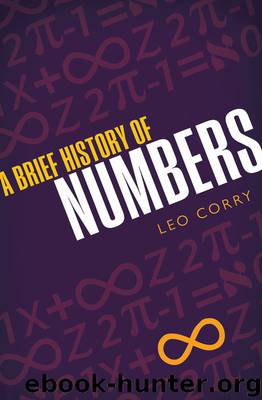A Brief History of Numbers by Corry Leo

Author:Corry, Leo
Language: eng
Format: epub
Publisher: Oxford University Press
Published: 2015-07-21T12:43:00+00:00
6.5 Euclid’s Elements in the Renaissance
I would like to conclude this chapter with a particularly illuminating perspective on the contemporary conceptions of number that arises from looking at various editions of Euclid’s Elements published in the fifteenth and sixteenth centuries in Europe. The many editions that appeared in print in Europe after 1450 often present original syntheses among different mathematical traditions, both scholarly (which were studied, taught, and disseminated in Latin, mainly among humanists and the Church institutions) and practical (which were developed and taught in vernacular languages). Those who prepared the editions typically added a preface as well as comments and explanations, but they did not work as historians or philologists preparing critical editions of classical texts, the way scholars would do nowadays. Rather, they simply saw themselves as making available a textbook for study at schools, and hence it was common that they would modify the original text to make it more easily understandable. For this reason, the editions of the Elements are a very useful source for the historian trying to assess changes in mathematical ideas throughout time. These editions show some significant changes in the understanding of number, and at the same time they show how pervasive the Greek basic ideas continued to be at the time. They continued to afford a necessary point of reference in the mathematical discourse of the time, particularly concerning the concept of number.
One important element that gradually entered the editions of the Elements, as well as many other contemporary mathematical books, was the implicit assumption that any magnitude can be measured. Accordingly, the issue of incommensurability, which had been the main motivation for Eudoxus’ formulation of a new theory of proportions to replace the old Pythagorean one, lost its importance. Some of the new editions of the Elements did not even mention this issue. As a consequence, there was a gradual identification of “ratio” with the numerical value of the fraction defined by the two magnitudes compared. As always, this was a hesitant and slow process, and yet it is clearly visible by the end of the sixteenth century and it gradually acquires momentum. On some occasions, a ratio between an integer and an irrational (for e.g., a root of a non-square integer) was written as a fraction whose value is an approximation of the irrational ratio in question.
One remarkable example that can be mentioned here is that of the 1574 edition prepared by the German Jesuit Christopher Clavius (1538–1612). Clavius was the most prominent figure in the educational system of the Jesuit Order, and he greatly influenced the study programs they implemented. Mathematics was always at the focus of interest of these programs. Clavius’ mathematical texts reached an enormous audience in Europe and, because of the missionary activity of the order, in many other places around the world as well. Clavius’ edition of the Elements, then, was among the most well known in his time. In the arithmetical books (VII–IX), he allowed himself a high degree of liberty in
Download
This site does not store any files on its server. We only index and link to content provided by other sites. Please contact the content providers to delete copyright contents if any and email us, we'll remove relevant links or contents immediately.
| Algebra | Calculus |
| Combinatorics | Discrete Mathematics |
| Finite Mathematics | Fractals |
| Functional Analysis | Group Theory |
| Logic | Number Theory |
| Set Theory |
Modelling of Convective Heat and Mass Transfer in Rotating Flows by Igor V. Shevchuk(6406)
Weapons of Math Destruction by Cathy O'Neil(6213)
Factfulness: Ten Reasons We're Wrong About the World – and Why Things Are Better Than You Think by Hans Rosling(4712)
A Mind For Numbers: How to Excel at Math and Science (Even If You Flunked Algebra) by Barbara Oakley(3256)
Descartes' Error by Antonio Damasio(3247)
Factfulness_Ten Reasons We're Wrong About the World_and Why Things Are Better Than You Think by Hans Rosling(3216)
TCP IP by Todd Lammle(3154)
Fooled by Randomness: The Hidden Role of Chance in Life and in the Markets by Nassim Nicholas Taleb(3079)
Applied Predictive Modeling by Max Kuhn & Kjell Johnson(3041)
The Tyranny of Metrics by Jerry Z. Muller(3026)
The Book of Numbers by Peter Bentley(2928)
The Great Unknown by Marcus du Sautoy(2661)
Once Upon an Algorithm by Martin Erwig(2620)
Easy Algebra Step-by-Step by Sandra Luna McCune(2603)
Lady Luck by Kristen Ashley(2552)
Police Exams Prep 2018-2019 by Kaplan Test Prep(2516)
Practical Guide To Principal Component Methods in R (Multivariate Analysis Book 2) by Alboukadel Kassambara(2512)
All Things Reconsidered by Bill Thompson III(2369)
Linear Time-Invariant Systems, Behaviors and Modules by Ulrich Oberst & Martin Scheicher & Ingrid Scheicher(2346)
